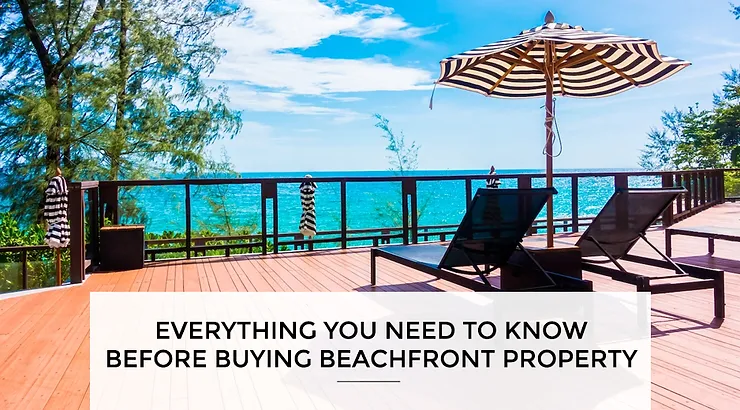We don’t have to convince you that living in a beachfront estate would be a dream come true– there’s hardly a person alive that hasn’t daydreamed about lounging on their porch and gazing out over the glistening water as the sun rises. Not only can living in a waterfront luxury home feel like you’re on a permanent tropical vacation, but a beachfront property also typically has a strong potential for appreciation.
At the same time, it’s important not to get completely swept away into the fantasy of living in your private paradise. Living right on the beach offers a truly unique experience to you and your family, but it also comes with special regulations, restrictions, weather risks, and considerations.
Before you start hunting for the ideal location for your new home, there are several things you’ll want to know about buying beachfront property. Choosing the perfect spot to build your dream house is never easy, but the process becomes even more multifaceted when dealing with properties right on the beach.
Factoring in HOA Fees
If you’re purchasing a pre-existing home or building your own in a homeowner’s association, you’ll want to consider the HOA fees when creating your budget. In some coastal places, many of the neighborhoods are run by HOAs; this doesn’t just impact how much money it will cost to inhabit your new home, but it can influence the actual experience of what it feels like to live in the neighborhood.
Before you purchase a property in an HOA, it’s a good idea to look into the covenants, conditions, and restrictions (CC&Rs) of the HOA; this can give you a sense of what it will be like to live in the community and whether it will fit with your lifestyle.

Beyond that, it’s important to recognize that low HOA fees might increase down the road. If an HOA is newer, the fees may be artificially low to sell homes and lots. Once the community becomes more established, you could find that the fees become quite a bit more substantial.
Lastly, HOAs can also restrict building styles, property use, and other issues ranging from lax to strict. Before buying a property in an HOA, you’ll want to familiarize yourself with its architectural guidelines, rules, policies, and procedures.
Homeowners Insurance
You’ll also find that homeowners insurance rates tend to be higher for beachfront properties versus further inland properties. As you might imagine, this is because insurance companies see beachfront property as having a higher risk of damage due to severe weather.
Zoning Laws, Building Codes, and Other Restrictions
There are going to be different zoning laws in every beach town, and you’ll want to familiarize yourself with the laws where you’re interested in building. There are usually setback requirements for most beach and waterfront properties and local setback requirements.
These requirements impact the footprint of your home and how near to the water it can be.
In many instances, you’ll find that building codes tend to be stricter in many locations with waterfront and beachfront homes. These codes typically require that your structure will be able to withstand the unique circumstance of being right on the water, mandating weather-resistant materials and installation assemblies along with better-performing mechanical elements and structural systems.

Suppose the lot or property you’re interested in is recognized as part of a federal, state, or local historic zone. In that case, there are usually additional developmental limits. Beyond zoning laws and building codes, beachfront property in a historic area might be subjected to additional regulations.
For a more in-depth look at what to expect when building a beachfront abode, take a look at our guide to restrictions and regulations on waterfront homes.
1. Sea and Elevation Levels
If you’re considering buying an oceanfront home, you won’t want to put the notion of sea levels on the back burner.

Sea levels are rising, so an important consideration should be a property’s elevation level when finding a lot that will work for your dream home.
2. Septic Systems, Wells, and Waterfront Amenities
Building along either fresh or saltwater bodies also means that there will be setback requirements for septic systems and freshwater wells, impacting how and where you install your systems and your home. Waterfront amenities like boathouses, bridges, and docks are also typically regulated.

Are you gearing up to build the house of your dreams along the coast of the Sunshine State? Make sure you look at our guides to the best custom home communities and the best builders in Florida. Before you start interviewing contractors, though, you’ll want to watch this video on how to select a builder.
3. Flood Zones
Many beachfront and coastal properties fall within flood zones; this doesn’t necessarily mean that you shouldn’t buy a property along the water, but it does mean you’ll want to think about how this could impact how and where you build your home.
Beyond that, being in a flood zone can make your building project more expensive. For example, meeting the required building codes for an oceanfront property can mean that the total cost of the project is 15% to 30% more.

In order to comply with coastal building codes, you’ll often have to use additional straps, ties, anchors, and hold-downs, as well as install windows with upgraded wind ratings. You’ll likely have to dedicate part of your budget to elevating the structure. Where do these added costs come from, you ask?
Construction in a coastal velocity zone or a flood zone is highly regulated. Agencies that govern coastal or inland wetland management mandate every stage of the drainage collection, storage, and release process to help reduce pollutants released into the environment, limit thermal discharge, and minimize erosion.
4. Erosion
The last thing you want is to buy your ideal beachfront property only to watch your beach slowly erode away. A number of natural occurrences can cause erosion, but the most damaging of these are typically the conditions associated with landfalling tropical storms and hurricanes.
Erosion isn’t a theoretical concern– roughly $500 million of coastal property loss every year occurs thanks to erosion, both in the loss of land and damage to structures. That being said, it’s worth noting that coastal erosion rates are highly localized.

There are a number of things that property owners can do to protect their property from erosion, but you’ll want to make sure that your state or local government permits projects like seawalls before deciding to move forward with a property purchase if this is how you think it would be best to mitigate the issue.
Ultimately, you want to know the erosion risk of any property you buy. The amount of land that serves as a buffer between the water and your home is something you’ll also want to take into consideration.
If your looking for additional information on beachfront properties, erosion, and other factors to consider, check out the article from our friends at Architectural Digest additional factors to consider when purchasing a beach home.
5. Weather Risks
You’re probably building your perfect home in a place where there are countless sunny, mild days throughout the year. At the same time, many of the locations in the US with the best weather and most gorgeous beaches are also prone to tropical storms, hurricanes, and other severe weather.

The weather risks you might face in a beachfront property will depend tremendously on where your estate is located. That being said, you’ll want to thoroughly research what you can expect from the weather throughout the year and whether the area you’re interested in is prone to hurricanes, wind storms, tsunamis, flooding, and more.
Take a look at the recent storm history in the area you’re interested in as a part of your research process. If you’re concerned about severe weather, you might try to find a property located in an area that is more protected, such as a sheltered bay.
6. Maintenance Costs
Living in an idyllic beachfront estate comes with additional costs, including more maintenance costs than you would typically accrue in an inland home. The type of maintenance and how much it will cost you each year will depend on a variety of factors, including whether your home is on a saltwater or freshwater body.
That lovely smell of the salty air near the ocean also means that corrosive salt water is being carried on the breeze, leaving many materials subject to corrosion.
If you move to a beachfront property, for example, you’ll find that anything made of steel and many of your electronics will tend to have a more limited lifetime.

Saltwater can also be problematically corrosive to concrete, including foundations, sidewalks, pilings, and structural walls. Wood isn’t safe from salt’s damaging effects, as the salt pulls the inner cell structures out of the wood and brought to the surface. The material can start to soften and crumble over time.
Another thing you’ll want to consider when deciding if you want to live on the water is mold prevalence in these climates. In warm, humid places, mold can build up quickly and damage wood, drywall, insulation, and flooring.
Beyond the damaging impact of salt, you’ll also want to consider that sand driven by wind can also be somewhat destructive. Both sand and salt can cause maintenance issues indoors, too, as they can be hard on furniture frames and upholstery.
7. Building With Specialty Materials
If you’re building your dream home along the coast, all of those maintenance considerations might leave you feeling somewhat overwhelmed. However, some specially treated materials that can be used during construction are designed to specifically deal with the impact of living right on the water.

It’s essential to work with a design and build team that is highly experienced in building on the water to ensure that no corners are cut or mistakes are made in material selection.
8. Designing With the Future in Mind
Maybe you’ve decided that you are going to live in your beautiful beach house for the rest of your life, and you want to keep the property in your family forever. On the other hand, maybe you aren’t entirely sure what the future holds. It’s worth considering the big picture when designing your beach estate, such as whether you might ever want to rent out the property or resell it.

Depending on your vision for the future, you could choose to let this information impact your design decisions as much as you choose. It isn’t worth building a home you don’t like just so you can maximize your profit down the road, but you also might find that, in some cases, it makes sense to make decisions based on what is practical for the property as an investment.
9. Local Tourism
Finally, another important consideration is whether there is a large amount of tourism during certain seasons and whether this will impact your experience living in your new home or community.
In some cases, living in a town with a seasonal tourist season might not be a problem at all. In fact, it can add a lively and vibrant atmosphere. In general, getting a feel for the area before purchasing a property is a good idea, as it is truly amazing how much an influx of people can change what it feels like to live in your town.

This is also relevant when considering how the beaches in your area (and in front of your home) are used. Will there be crowds of people right next to your property line during peak season? How will tourists in your area and along the beaches impact your feeling of privacy in your new home?
In Hawaii, there’s no such thing as a “private beach.” You can even find guides online on how to visit the beach in front of the house of Facebook’s CEO. In other states, owning parts of the beach and shoreline is possible. Knowing precisely where those boundary lines are is important before pulling the trigger on the land.
While it’s easy to get caught up thinking about zoning regulations and setbacks as you consider building your dream home, it’s important not to overlook one of the most important elements of your search for beachfront property– whether your home will provide a comfortable and supportive environment for you and your family.
Navigating the Wild Seas of Building Your Dream Home
The luxury home-building process often stretches beyond anticipated deadlines and bursts through the expected budget. This can turn a process that should be absolutely exhilarating into a stressful, overwhelming nightmare.
When you’re considering building on beachfront property, this effect is potentially multiplied. It can sometimes feel like restrictions and regulations are coming at you from all angles– from your HOA, coastal management agencies, building codes, zoning laws, etc.
None of this means that turning your dream into a reality is impossible. It does mean that thorough research is required before you make an offer on a piece of land.
At Dream Home Studios, our mission is to help people just like you acquire the posh, luxurious home you’ve always wanted. We are all too familiar with how often home-building projects go over budget and off-schedule, which is why we’ve created our unique step-by-step program.
When you use our Custom Home Guidebook and Workshop, you can rest assured that you can build the home you’ve imagined while enjoying and staying in control of the process.







